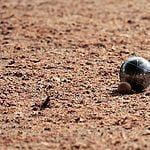While some may argue that comparing the difficulty of squash and badminton is like comparing apples to oranges due to their contrasting styles, it's worth considering the unique challenges each sport presents to you as a player.
In badminton, you're constantly on your toes, leaping for those high shuttlecocks and engaging in rapid-fire volleys that test your reflexes and endurance. Meanwhile, squash demands your agility and strategic thinking, as you navigate the confined space of the court to outmaneuver your opponent with a ball that's hurtling at high speeds.
Both sports offer a rigorous workout, but the devil is in the details, and as you peel back the layers of what makes each sport tick, you'll find the nuanced skills that set them apart.
How do these differences translate into the level of difficulty for the average player, and what might that mean for you if you're considering taking up one of these sports? The answer isn't straightforward, but as we explore the intricacies of squash and badminton further, you'll discover which sport might just challenge you in ways you hadn't anticipated.
Key Takeaways
- Squash is considered one of the toughest racket sports, requiring high cardiovascular endurance and quick recovery between rallies.
- Badminton singles play focuses on endurance and precision, while doubles play requires swift and coordinated attacks and defenses.
- Squash players must exploit the presence of walls for aggressive shots or defensive angles, while badminton players need to master overhead shots and jumps.
- Both sports require excellent reflexes, anticipation, and game speed, with shuttlecock speeds in badminton reaching up to 200 mph and squash ball speeds exceeding 150 mph.
Court Dimensions and Layout
While both badminton and squash courts adhere to precise dimensions and markings to facilitate fair play, they present unique spatial challenges that influence gameplay and tactics.
In badminton, the court dimensions and layout are governed by the Laws of Badminton. For singles play, you're confined to a narrower space, 44 feet by 17 feet, compared to the full 20-foot width used in doubles. This shift impacts how you strategize and move; singles players often focus on endurance and precision, while doubles play requires swift, coordinated attacks and defenses.
On the squash court, the enclosed 32 feet by 21 feet area demands that you adapt to a different kind of play. The presence of walls adds a three-dimensional aspect that squash players must exploit, unlike in badminton or tennis. You need to anticipate the ball's rebound and use the walls to create aggressive shots or tight defensive angles.
Both racket sports require you to internalize the court's spatial dynamics. As a player, mastering the court dimensions and layout is crucial for developing effective game strategies.
Whether you're a squash player seeking to control the T, or a badminton enthusiast aiming to outmaneuver your opponent, understanding these spatial constraints is key to excelling in these challenging racket sports.
Equipment and Gear Differences
The distinct equipment and gear required for squash and badminton reflect the physical demands and gameplay styles of each sport. When you delve into equipment in this cross-discipline, it's clear that each requires specialized gear to meet its unique challenges. Here are some key differences:
- Rackets: In badminton, you'll use a lighter racket such as the Yonex Muscle Power, built for speed and flexibility. Squash rackets, on the other hand, are heavier and stiffer, designed to withstand the force of striking a harder ball.
- Grips: You might prefer a towel grip for badminton to absorb sweat and enhance control, while in squash, a durable replacement grip or synthetic grip can better withstand the rigors of play.
- Clothing: Badminton clothing is typically lightweight and breathable to accommodate rapid movements and maintain comfort during long matches.
Behind these items lies a critical discussion among people about the stringing technique and tools that vary significantly between squash and badminton. String tension and durability are paramount, with each sport demanding a particular balance to optimize performance. Understanding these differences is crucial whether you're a seasoned player or just starting in either sport.
Physical and Cardiovascular Demands
Squash demands an exceptional level of physical fitness and cardiovascular capacity. Players often endure heart rates peaking at 190-200bpm and cover an average distance of 2.5 kilometers per match. This statistic alone positions squash as one of the toughest racket sports in the world.
The sport requires not just agility and skill, but a body conditioned for extremely demanding play. Professional players embody the peak of what it means to play squash at the highest level. Take, for example, Mathieu Castagnet, whose endurance and ability to recover quickly are hallmarks of a top-tier squash athlete. These professionals showcase just how taxing the sport can be on the body, especially during the Professional Squash Association (PSA) tournaments where new data on players' physical exertion is recorded.
Players cover considerable ground in a confined space, responding to the unpredictable nature of the squash ball with lunges and rapid directional changes. The short recovery time between rallies, averaging merely 4-10 seconds, further underscores the intense physical and cardiovascular demands placed on those who partake in this extremely demanding sport.
Each match is a testament to squash's reputation as a comprehensive workout, challenging even the most seasoned athletes.
Technique and Skill Mastery
Mastering the techniques and skills in both badminton and squash is essential for players aiming to excel, as each sport presents unique challenges that test precision, timing, and strategic play. While badminton's rapid shuttlecock speeds of up to 200mph require quick reflexes, squash's ball can exceed 150mph, demanding sharp anticipation.
Here's how you can understand the nuances of technique and skill mastery in these sports:
- Badminton Technique: Skill mastery in badminton involves mastering overhead shots and jumps. It's hard to make sure you're always ready to hit the ball with power and accuracy, especially during high-speed tournament play.
- Squash Precision: Squash calls for a professional level of precision to exploit the four walls. The satisfying thwack when you hit the ball just right comes from years of refining your technique.
- Training and Play: Both games require different muscle groups. To play in your area and beyond, focus on the lower body for badminton, while squash will have you developing a powerful upper body.
In both badminton and squash, skill mastery isn't just about physical prowess; it's about the mental game, understanding your opponent, and outmaneuvering them with strategic play.
Game Speed and Reaction Time
When considering the intense pace of both squash and badminton, it's clear that a player's success hinges on their ability to refine reaction times and accelerate game speed through targeted training. Both sports not only challenge your physical prowess but also put your mental agility to the test.
In the game of badminton, shuttlecock speeds can soar up to a blistering 200 mph, demanding lightning-fast reflexes. Professional players must possess the dexterity to respond instantaneously, a skill honed by relentless practice. The latest about Badminton Central may offer insights on the correct speed of shuttle, and forums like SaxoProf could be buzzing with discussions on optimizing game speed from a professional point of view.
Squash, on the other hand, while a smaller court sport, isn't lacking in velocity, with ball speeds surpassing 150 mph. The community is running drills designed to improve reaction time, with players actively seeking badminton-related classified ads for equipment that could give them an edge.
To keep up with the badminton market around you, it's crucial to engage in exercises that foster the explosive movements required for both sports. By integrating these practices, your game speed and reaction time will improve, keeping you competitive on the court.





